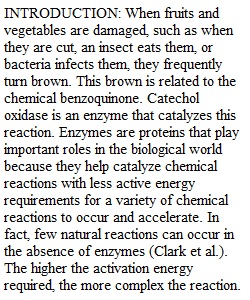


Q Organization of Your Enzyme Lab Paper Organize your lab paper into sections using the following headings, which must be included in your paper: Cover Page Introduction Methods Results Discussion Conclusions References This Enzyme paper may be shorter than the Water or Membrane paper since there are fewer experiments. You only need to write about your group’s experiment from Lab 8 part 2. Introduction—explain why the class’s experiments were done. Summarize the overall purpose of the whole lab, and the types of experiments that were done, as well as hypotheses tested. • Provide background information (may have references and citations) that helps the reader to understand your hypotheses and experiments. • Should be short—usually about 4 to 6 sentences. Methods—describes what was done and how it was done. Describe your methods that were NOT written in the Lab Manual and Lab 8 Supplement. You must cite the Lab Manual as containing many of the methods you used, but you must describe details that are not included in the Lab Manual. Give enough detail so that your group’s and class’s experiments could be repeated by someone else. Results—describes what you observed or measured. • Your Results must begin with sentences that summarize the data and their trends (patterns). Then, include appropriate graphs or tables. • Present the data from your group in a table or graph, as specified earlier. • Characteristics of good graphs: * Are incorporated in the body of paper, not at the end of the paper. * Should show patterns or trends that enable data to be readily analyzed. * Should have descriptive headings (titles)—see the Sample Lab Paper (D2L). Descriptive means enough information is provided so that a reader can interpret the graph (or table) without having any additional information. Headings are frequently in the following format: The effects of (independent variable) on (dependent variable). * Should have independent and dependent variables on the appropriate axes. * Should be drawn to scale by having each unit along an axis representing the same magnitude. * Should have each axis labeled with the variable and its units of measure, and have the major divisions along the axis numbered. * Should present continuous data in line graphs. * Should present discrete or categorical data in bar graphs. * Should be computer generated (Excel of another spreadsheet program). • Characteristics of good tables: * Are incorporated in the body of paper, not at the end of the paper. * Should have descriptive headings (titles)—see above. * Are probably best used for qualitative data, or for data that are too simple to present in a graph. Discussion—explains why the results were obtained and explains the importance (relevance) of the results. You must explain how and why the results occurred at the molecular level. Be accurate and detailed. Do NOT copy sentences from your textbook. Please also include some discussion of why and how your variable might affect the rate of enzymatic reactions in real cells. If the data do not match your expectations be sure to discuss potential causes for the discrepancies. • This is the most important and longest section, and should take the most time to write. • In this section you interpret the data and explain why the experiments worked the way they did. This will usually require that you reread the Lab Manual carefully and understand the material in your textbook and lecture notes. You must use (and cite) appropriate scientific references in each discussion. • Include chemical explanations—what was happening at the molecular level that caused your results to occur? • Include biological explanations—what is the relevance of your results to living organisms? • Are there any know errors that likely affected your results? • What would you do differently to reduce any errors if you repeated the experiment? Conclusions—Summarizes the major ideas of the experiments and lab paper • An overall summary of the major experiments, including what scientific principles were observed, hypotheses that were supported or not supported, what you learned, what is still unknown or inconclusive, and what could be explored in future experiments. • Should be short—usually about 6 to 8 sentences.
View Related Questions